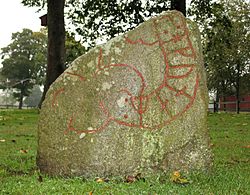Haakon Ericsson facts for kids
Haakon Ericsson (also spelled Håkon Eiriksson) was an important leader in Norway a long time ago. He was the last Earl of Lade, which was a powerful title for a ruler in Norway. Haakon governed Norway twice, first from 1012 to 1015, and then again from 1028 to 1029. During these times, he ruled as a "vassal," meaning he was loyal to and served the powerful Danish King Knut the Great. Haakon Ericsson passed away around the years 1029 or 1030.
Haakon's Story
Early Life and Family
Haakon Eiriksson came from a strong family of Norwegian leaders. They lived in the eastern part of Trondheim, near the Trondheimsfjord. His father was Eirik Håkonson, who was also a ruler in Norway and later became the Earl of Northumbria in England. People generally believe that Haakon's mother was Gytha. She was the daughter of Sweyn Forkbeard, a famous Danish king, and the half-sister of King Knut the Great. This family connection made Haakon part of a very important royal network.
Ruling Norway
After a big battle called the Battle of Svolder, Haakon's father, Eirik Håkonson, and his uncle, Sveinn Hákonarson, became rulers of Norway. They ruled under the Danish King Sweyn Forkbeard. Around 1014 or 1015, Haakon's father, Eirik, left Norway to join King Knut's military campaign in England. After Knut took control of northern England, he gave the earldom of Northumbria to Eirik. Eirik stayed there as an earl until he died sometime between 1023 and 1033.
When his father left, Haakon Eiriksson took over as ruler of Norway in 1012. He ruled as a "vassal" for King Knut, meaning he governed Norway on Knut's behalf. He had an important helper named Einar Tambarskjelve. His uncle, Sveinn Hákonarson, also controlled some areas of Norway, but he was loyal to the Swedish king.
Challenges and Return
After being away in England for a few years, Olaf Haraldsson (who later became Saint Olaf) returned to Norway in 1015. He declared himself king and gained support from many local leaders. In 1016, Olaf defeated Haakon's uncle, Sveinn Hákonarson, at the Battle of Nesjar. After this defeat, Haakon fled to England.
In England, King Knut welcomed Haakon and made him the Earl of Worcester. Haakon also became known as the ruler of the Kingdom of the Isles (islands off Scotland) from 1016 until 1030. Later, in 1028, many Norwegian nobles decided to support King Knut. Because of this, Haakon Eiriksson returned to Norway to rule again as King Knut's representative.
His Final Years
Haakon's second time ruling Norway was short. He died in a shipwreck. This happened in the Pentland Firth, which is a dangerous stretch of water between the Orkney Islands and the Scottish mainland. His death occurred either in late 1029 or early 1030.


